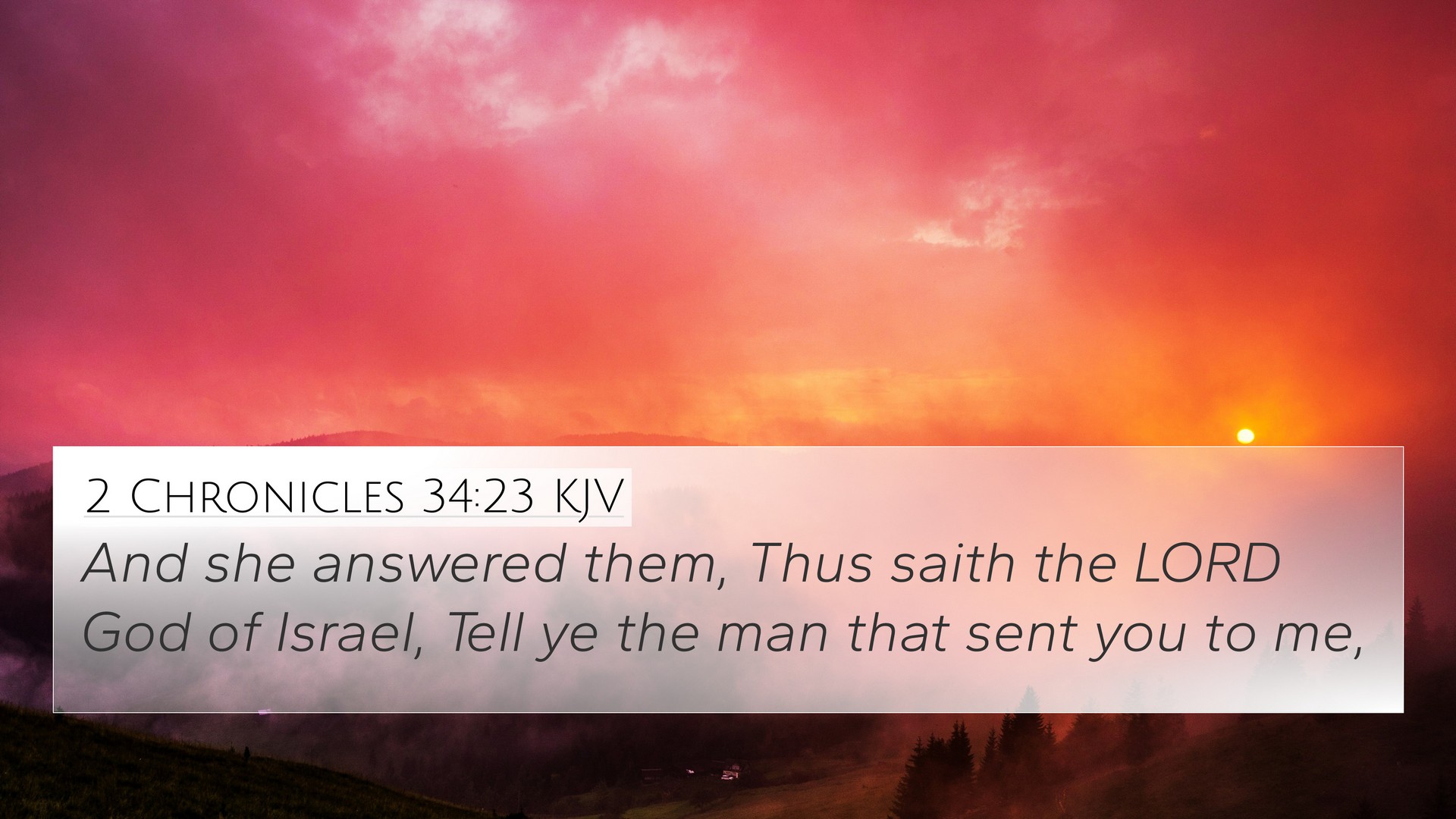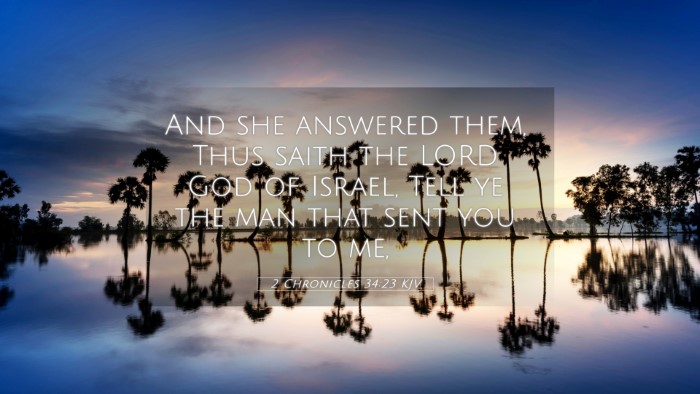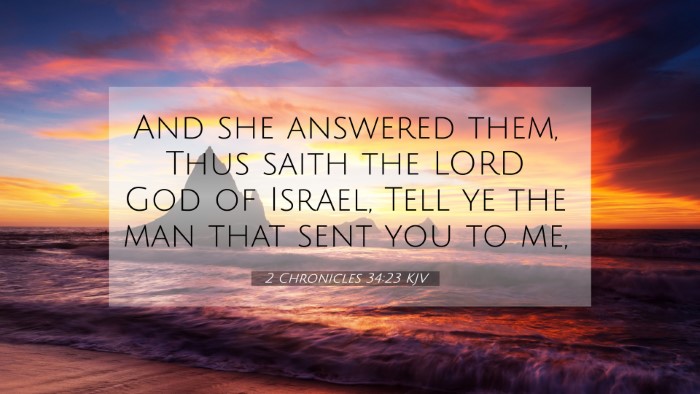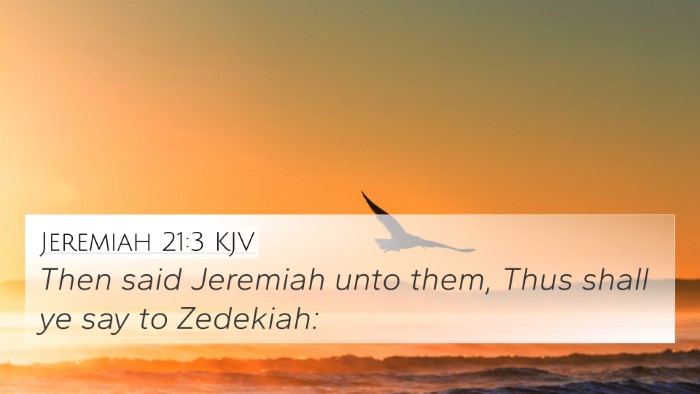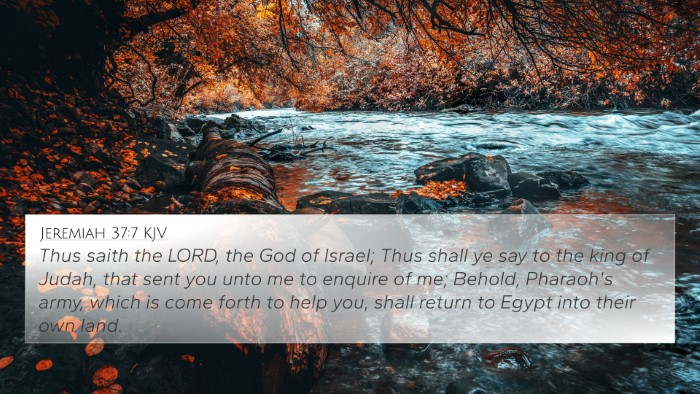Understanding 2 Chronicles 34:23
Bible Verse: 2 Chronicles 34:23
Verse Text: "And she answered them, Thus saith the Lord God of Israel, Tell ye the man that sent you to me." (2 Chronicles 34:23, KJV)
This verse serves as a crucial element in the narrative during King Josiah's reign and his efforts towards religious reform. To fully grasp its meaning, we can draw from multiple commentaries and explore the connections between various Bible verses.
Summary of Insights
The interpretation of this verse can be enriched by examining the insights provided by renowned public domain commentators.
Matthew Henry's Commentary
Matthew Henry emphasizes the significance of the prophetic message delivered through Huldah, the prophetess. He notes that God's communication, represented by Huldah, was a divine affirmation of the reforms Josiah was enacting. Henry highlights that God recognizes sincere acts of repentance and seeks to guide His people through the prophetic word.
Albert Barnes' Commentary
Albert Barnes details the situational context of Huldah’s response, illustrating how it serves as a transition in the narrative of Josiah’s reign, emphasizing God's enduring presence among His people despite their history of disobedience. Barnes examines the act of seeking divine counsel as a reflection of the king’s humility and earnestness in reform.
Adam Clarke's Commentary
Adam Clarke points out the importance of Huldah's role as a female prophet in a patriarchal society, indicating a broader divine message that transcends gender. Clarke reflects on the implications of Huldah’s prophecy for future generations, stressing the importance of returning to the Lord and following His commandments, aligning with the theme of restoration.
Key Themes and Inter-Biblical Connections
This verse presents various themes that resonate throughout the Scriptures, creating meaningful connections with other biblical texts. Below are some critical connections:
- 2 Kings 22:14-20 - This passage recounts the visit to Huldah and her prophecy of doom, mirroring the essence of consultation and divine revelation found in 2 Chronicles 34:23.
- Isaiah 30:10-11 - This scripture reflects the rejection of prophetic truth, contrasting with Josiah’s acceptance, which poses significant themes of obedience and divine prophecy.
- Jeremiah 26:16-19 - This passage shows the response to true prophets; it helps illustrate the broader context of Josiah's reformative actions.
- Deuteronomy 18:18-22 - It highlights the criteria for a true prophet, linking God's communicative nature through prophecy, as seen in Huldah's message.
- Luke 2:36-38 - Anna, another prophetess, exemplifies the role of women in prophetic ministry, akin to Huldah's impactful message in 2 Chronicles 34.
- Acts 21:8-9 - The mention of Philip's daughters who prophesied connects across the New Testament, reflecting on God's ongoing communication.
- James 5:16 - This verse describes the power of prayer, paralleling the responses to prophetic guidance exhibited in Josiah's actions.
Tools for Bible Cross-Referencing
To deepen one’s understanding of verse connections, several tools can enhance the experience of Bible study:
- Bible Concordance: A valuable tool for finding keywords and related verses.
- Cross-Reference Bible Study: Engaging in comparative analysis to uncover thematic similarities.
- Bible Cross-reference Guide: Offers systematic approaches to navigate inter-related scriptures.
- Bible Chain References: A method that links verses to create broader themes.
How to Use Bible Cross-References
Understanding cross-references involves:
- Identifying Themes: Focus on the main themes from specific verses to find related scriptures.
- Utilizing Study Guides: Leverage online or print resources to track scriptural connections.
- Engaging in Community Conversations: Discuss with peers to discover new insights.
- Reflecting on Applications: Contemplate how connections influence modern-day applications and interpretations.
Bible Cross References for Sermon Preparation
When preparing sermons, exploring cross-references aids in building a comprehensive message. For example:
- Focus on 2 Chronicles 34:23 in conjunction with 2 Kings 22:14-20 for a deeper understanding of prophetic narratives.
- Use Isaiah 30 alongside James 5 to discuss the relevance of heeding prophetic voices.
- Compare and contrast Jeremiah 26:16-19 with Luke 2:36-38 to illustrate the continuity of prophetic ministry.
Conclusion
2 Chronicles 34:23 serves as an essential reminder of God's willingness to communicate with His people, evoking insight not only from the verse itself but also through its connections with broader biblical narratives. By utilizing cross-references, the believer can delve into a richer understanding of scripture and its implications for faith and practice.
